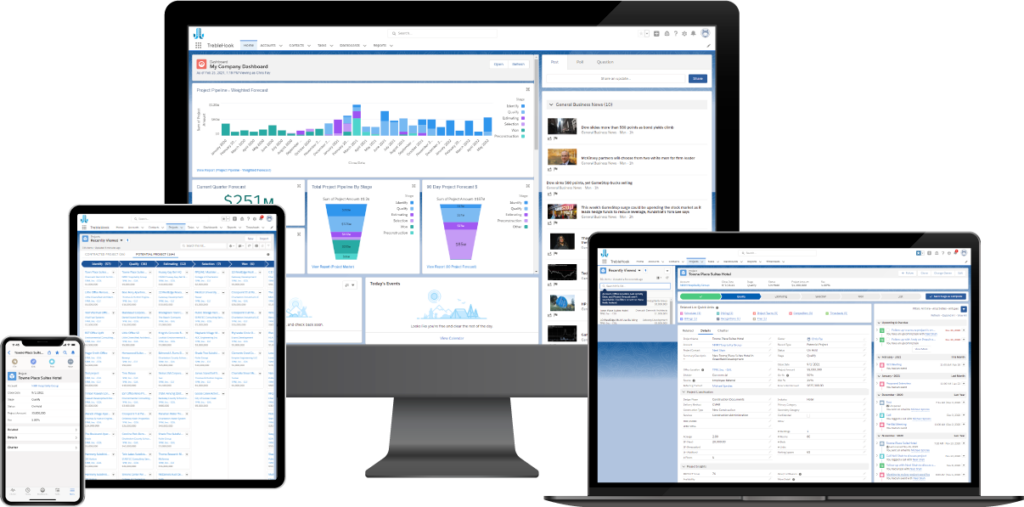It’s amazing how our life experiences continue to shape and define our future.
After a successful career as a Project Manager and Director of Business Development for a regional general contractor, I joined TPM. Our sister company, TPM, is a family business founded in 1973 by my father-in-law, Jerry Cooper. We serve customers in AEC and manufacturing industries with professional services, hardware, and software solutions.
Over my past eleven years at TPM, we have focused on transforming an already successful business into a technology powerhouse. This transformation has allowed us to address some of our customers’ most advanced needs across the Southeast. However, the conversion wasn’t easy. It had us look, both externally and internally, to change our company daily and weekly for the future.
The Early Stages of TrebleHook
During our annual planning process a few years back, we spent a significant amount of time talking to our architecture, engineering, construction, and manufacturing customers.
We sought to understand customer needs and pain points better to help them grow their companies. We uncovered common issues relative to data management, design workflows, training, and technology adoption. However, we also saw a significant gap in our mid to large AEC customers in two other critical areas.
One of the most painful and recurring problems we found was their project pursuit process. The project pursuit process is what companies undergo to identify, pursue, and win design and construction projects.
Sometimes companies would leverage a CRM tool for this process, and sometimes there was no CRM tool in place. When there was a CRM in place, typically, it was not industry-focused. These tools were not engineering CRM software, construction CRM software, or software geared towards architects or manufacturers.
Second, we spoke to many executives who lacked transparency in their business performance and key performance indicators. This lack of transparency was detrimental to making appropriate business decisions for the future.
As we dug in more with executives, business development, and marketing professionals of these AEC firms, we kept hearing and witnessing:
A Severe Lack of Centralized Project Data
Project data was all over the place. It was in spreadsheets, ERP systems, various CRM solutions, file folders, or worst of all, in the head of the employees. This decentralized project data had teams struggling to find information about specific projects.
Teams were also unable to collaborate between departments or locations properly. Larger customers had locations and divisions doing things so differently that it was nearly impossible to assemble data.
- Business development and marketing teams were trying to chase down information from various project teams to help win the subsequent pursuit.
- Executives had their administrative staff compile data manually to have some semblance of a dashboard or report.
- IT professionals were trying to spin up Microsoft Power BI dashboards to bring light to crucial business insights.
When companies finally pulled data together, it was frequently inaccurate or incorrectly used.

No Consistent or Scalable Way to Manage Customer & Prospect Relationships
Relationships were at the heart of architecture, construction companies, and engineering firms’ businesses. However, no consistent way to manage and connect with customers and prospects existed. For instance, various team members would call the same company or person without knowledge of prior contact.
Additionally, client databases lived in Outlook, Excel, or sporadically across multiple systems. Therefore, marketing was unable to differentiate customers from prospects. Contact lists were very out of date.
Team members had a hard time consistently documenting customer communication, meetings, and tasks. Consequently, teams often relied on administrative staff to handle documentation.
Project Pipelines Were Unreliable and Not Focused in the Right Direction
Project pipelines and forecasts were unreliable and lacked consistency across the company. Various departments managed potential projects differently, making collaboration challenging. Because of this, customers could not clearly define their ideal project profile or the most profitable projects.
Most firms did not have any formalized Go/No-Go process in place. They relied on “gut” instinct rather than data to drive decisions. This led to chasing more quantity than quality projects, driving up their cost of pursuit and chasing a lot of the wrong projects. New divisions or locations focused too much on relationships and not enough on the type of work they were seeking. Finally, firms constantly complained about competition getting more challenging.
Poor Adoption and Utilization of Current CRM Tools
If any were in place, current CRM tools lacked utilization and adoption. Business development and marketing teams complained of being provided with non-intuitive tools and inconsistent workflows. There was also a lack of customization capabilities and overall general knowledge of maximizing the tool’s capabilities. Many mainstream tools like Hubspot CRM or Salesforce were sometimes used but not customized for the AEC industry.
Trying to find partners who understood the AEC industry was few and far between and frequently expensive to use. CRM software like Cosential or Vantagepoint was customized for architecture, engineering, and construction but was antiquated in its interface. These solutions lacked vital features and were cumbersome to use, leading to a lack of utilization. Tools with no integration into key company project management or ERP systems lead to low-value data.
An Example of Industry Built CRM for Our Company
As I listened to these customer pain points and challenges, I couldn’t help but reflect on where TPM was years ago. We lacked the proper process and tools to help our company scale. The tools we did have were not intuitive and not integrated, leaving data silos across our company.
These insufficient tools led to a severe lack of adoption and utilization amongst our teams. This lack of adoption led to inaccurate data reporting for our leadership team. We knew we had to make a change.
We knew that we needed to reset our foundation to grow our organization. We also knew that we needed to recruit and retain the very best talent and drive consistent processes across our locations and divisions.
One thing we talk a lot about at TPM is ensuring we have a solid foundation for growth. Any cracks in our foundation only get more prominent with scale, so the time is always “now” to fix the foundation.
We searched high and low for the right technology and partner to help us. We looked at best-in-class CRM and ERP tools with impressive capabilities and functionality. Still, these tools would require extensive customization to mold the solution for our business. We also found several industry-specific tools, but they were not intuitive and would ultimately lead to poor adoption.
Just before making our decision, we came across an organization that had built a solution utilizing the Salesforce infrastructure, the #1 CRM tool worldwide. The organization had created what would have taken an implementation partner years to make. The software had connections to our ERP system already built out of the box. It also had processes and terminology that fit our business and models.
Best of all, it was all built leveraging the infrastructure of Salesforce. Salesforce’s platform gave our team the most manageable and scalable CRM system to grow our company.
We committed and were off to the races. Fast forward nearly five years now, and it was one of the single best decisions I ever made for our company. Having an industry-built solution accelerated onboarding and adoption faster than I have ever seen.
Having a tool built on the Salesforce platform immediately gave our teams full connectivity. This connectivity was fun to use and drove massive utilization, providing far better data for the company. Most importantly, it gave my leadership team and I insights into our business that nurtured accountability, performance, decision making, and growth.

Bringing It Together Into a Solution Tailored for the AEC Industry
Above all, we listened to our customers. We heard pain points in project pursuit with executives, business developers, and marketers. We saw a lack of adequate and integrated tools in AEC. We experienced the life change and benefits of investing in an industry-specific solution for our company, leveraging the Salesforce platform.
That was it! We would develop an industry-specific project pursuit solution for architecture, engineering, and construction leveraging the #1 worldwide CRM, Salesforce. BOOM! TrebleHook was born (I will tell you later a future blog about how we got our name).
After what I like to refer to as the “making the sausage” period of our journey, we developed a partnership with Salesforce. From this, we started our new company, TrebleHook, built our first product, and showcased it to several customers. These preliminary customers were amazed at what we had done. From this, we implemented our first few systems, and now we are off the races.
The Three Prongs of TrebleHook
Our new solution TrebleHook is a three-pronged approach to Project Pursuit. We help Executives, Business Developers, and Marketers:
- Centralize and Leverage Project Data
- Enhance Customer Relationship Management
- Pursue and Win the Right Projects
We don’t just want our customers to win more work; we want them to win the right work. The right work differentiates them, makes them more money, and allows them to scale efficiently.
Oh, and the best part? We do all the heavy lifting for implementation and adoption. Our goal is to have our customers up and running with TrebleHook in 30 days or less. Crazy, right?
The Launch of TrebleHook
Now it is time to tell our story and where TrebleHook stands today.
We are a young company backed by the horsepower and expertise of our sister company TPM getting ready for scale. We have worked hard to identify our Ideal Customer Profile, much like our customers’ Ideal Project Profile.
More specifically, we have found the highest value in mid to large AEC firms with multiple locations or divisions. These companies, generally, have some level of dedicated business development and marketing as well. Most customers either have a competitive solution in place that they don’t like, or they don’t have a solution at all.
As we roll out TrebleHook to our customers and prospects across the country, we are always encouraged and motivated by our conversations, demos, and every customer we help. Are you ready to Pursue and Land the Right Projects? Let’s schedule a meeting.
